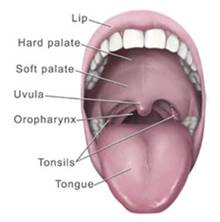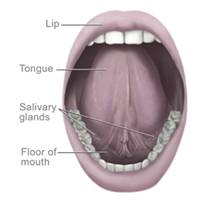Oral Cancer
Introduction:
Each year in the United States, about 29,000 people learn they have cancer* of the oral cavity (the mouth and lips) or the oropharynx (the part of the throat at the back of the mouth).
This page has important information to help people with oral cancer and their family and friends better understand this disease. It discusses possible causes, symptoms, diagnosis, and treatment of the disease. It also has information about rehabilitation and about sources of support to help patients cope with oral cancer.
Scientists are studying oral cancer to learn more about this disease, and doctors are exploring new ways to treat it. This research keeps increasing our knowledge about oral cancer. The Mouth and Throat
This booklet is about cancers that occur in the mouth (oral cavity) and the part of the throat at the back of the mouth (oropharynx). The oral cavity and oropharynx have many parts:
- Lips
- Lining of your cheeks
- Salivary glands (glands that make saliva)
- Roof of your mouth (hard palate)
- Back of your mouth (soft palate and uvula)
- Floor of your mouth (area under the tongue)
- Gums and teeth
- Tongue
- Tonsils

This picture shows the parts of the mouth and throat.

This picture shows the area under the tongue
Understanding Cancer
Cancer begins in cells, the building blocks that make up tissues. Tissues make up the organs of the body.
Normally, cells grow and divide to form new cells as the body needs them. When cells grow old, they die, and new cells take their place.
Sometimes this orderly process goes wrong. New cells form when the body does not need them, and old cells do not die when they should. These extra cells can form a mass of tissue called a growth or tumor.
Tumors can be benign or malignant:
- Benign tumors are not cancer:
- Benign tumors are rarely life-threatening.
- Generally, benign tumors can be removed, and they usually do not grow back.
- Cells from benign tumors do not invade the tissues around them.
- Cells from benign tumors do not spread to other parts of the body.
- Malignant tumors are cancer:
- Malignant tumors are generally more serious than benign tumors. They may be life-threatening.
- Malignant tumors often can be removed, but sometimes they grow back.
- Cells from malignant tumors can invade and damage nearby tissues and organs.
- Cells from malignant tumors can spread to other parts of the body. The cells spread by breaking away from the original cancer (primary tumor) and entering the bloodstream or lymphatic system. They invade other organs, forming new tumors and damaging these organs. The spread of cancer is called metastasis.
Oral Cancer
Oral cancer is part of a group of cancers called head and neck cancers. Oral cancer can develop in any part of the oral cavity or oropharynx. Most oral cancers begin in the tongue and in the floor of the mouth. Almost all oral cancers begin in the flat cells (squamous cells) that cover the surfaces of the mouth, tongue, and lips. These cancers are called squamous cell carcinomas.
When oral cancer spreads (metastasizes), it usually travels through the lymphatic system. Cancer cells that enter the lymphatic system are carried along by lymph, a clear, watery fluid. The cancer cells often appear first in nearby lymph nodes in the neck.
Cancer cells can also spread to other parts of the neck, the lungs, and other parts of the body. When this happens, the new tumor has the same kind of abnormal cells as the primary tumor. For example, if oral cancer spreads to the lungs, the cancer cells in the lungs are actually oral cancer cells. The disease is metastatic oral cancer, not lung cancer. It is treated as oral cancer, not lung cancer. Doctors sometimes call the new tumor "distant" or metastatic disease
Oral Cancer: Who's at Risk?
Doctors cannot always explain why one person develops oral cancer and another does not. However, we do know that this disease is not contagious. You cannot "catch" oral cancer from another person.
Research has shown that people with certain risk factors are more likely than others to develop oral cancer. A risk factor is anything that increases your chance of developing a disease.
The following are risk factors for oral cancer:
- Tobacco: Tobacco use accounts for most oral cancers. Smoking cigarettes, cigars, or pipes; using chewing tobacco; and dipping snuff are all linked to oral cancer. The use of other tobacco products (such as bidis and kreteks) may also increase the risk of oral cancer. Heavy smokers who use tobacco for a long time are most at risk. The risk is even higher for tobacco users who drink alcohol heavily. In fact, three out of four oral cancers occur in people who use alcohol, tobacco, or both alcohol and tobacco.
- Alcohol: People who drink alcohol are more likely to develop oral cancer than people who don't drink. The risk increases with the amount of alcohol that a person consumes. The risk increases even more if the person both drinks alcohol and uses tobacco.
- Sun: Cancer of the lip can be caused by exposure to the sun. Using a lotion or lip balm that has a sunscreen can reduce the risk. Wearing a hat with a brim can also block the sun's harmful rays. The risk of cancer of the lip increases if the person also smokes.
A personal history of head and neck cancer: People who have had head and neck cancer are at increased risk of developing another primary head and neck cancer. Smoking increases this risk.
Quitting tobacco reduces the risk of oral cancer. Also, quitting reduces the chance that a person with oral cancer will get a second cancer in the head and neck region. People who stop smoking can also reduce their risk of cancer of the lung, larynx, mouth, pancreas, bladder, and esophagus. There are many resources to help smokers quit:
- Also, your doctor or dentist can help you find a local smoking cessation program.
- Your doctor can tell you about medicine (bupropion) or about nicotine replacement therapy, which comes as a patch, gum, lozenges, nasal spray, or inhaler.
Some studies suggest that not eating enough fruits and vegetables may increase the chance of getting oral cancer. Scientists also are studying whether infections with certain viruses (such as the human papillomavirus) are linked to oral cancer.
If you think you may be at risk, you should discuss this concern with your doctor or dentist. You may want to ask about an appropriate schedule for checkups. Your health care team will probably tell you that not using tobacco and limiting your use of alcohol are the most important things you can do to prevent oral cancers. Also, if you spend a lot of time in the sun, using a lip balm that contains sunscreen and wearing a hat with a brim will help protect your lips
Symptoms
Common symptoms of oral cancer include:
- Patches inside your mouth or on your lips that are white, a mixture of red and white, or red
- White patches (leukoplakia) are the most common. White patches sometimes become malignant.
- Mixed red and white patches (erythroleukoplakia) are more likely than white patches to become malignant.
- Red patches (erythroplakia) are brightly colored, smooth areas that often become malignant.
- A sore on your lip or in your mouth that won't heal
- Bleeding in your mouth
- Loose teeth
- Difficulty or pain when swallowing
- Difficulty wearing dentures
- A lump in your neck
- An earache
Anyone with these symptoms should see a doctor or dentist so that any problem can be diagnosed and treated as early as possible. Most often, these symptoms do not mean cancer. An infection or another problem can cause the same symptoms





































